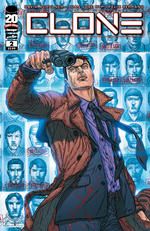"Clone" #2 is distinguished by graceful world-building and fast-paced action from David Schulner and Juan Jose Ryp. Schuler avoids the common genre pitfall of too much exposition, and "Clone" #2 is also an improvement over "Clone" #1 in sophistication of plotting.
"Clone" #1 wasn't a bad debut, but it was difficult to tell if the story had any depth past its "clone meets clone" hijinks, especially because the plot of "Clone" #1 hinged on the tired cliche of a kidnapping of the protagonist's wife, with the additional drama of said wife being pregnant.
Schulner opens "Clone" #2 in Washington D.C., as Vice President Charles must decide on his public response to stem cell funding. The man is cast as a possible villain, and his motivations are clear while his opinions are gratifyingly murky. All political villains should have such subtlety of psychology. Historically, science fiction has had a conflicted relationship with science and technology. Science fiction stories often celebrate the possibilities of science. However, just as many stories come from the opposite angle, imagining or extrapolating terrible consequences to scientific advances unaccompanied by legal safeguards or a thought to moral consequences. These doomsday-prophesying stories turn on the classic theme of hubris, with the author as omniscient Greek chorus.
"Clone" leans more towards messy consequences than towards awe and pride in human ingenuity, but so far, Schulner has chosen a quiet, shades-of-gray approach to cloning. Without ignoring lightning-rod issues entirely, Schulner touches on ethics but prefers to focus more on narrative action.
Clone stories are also just a more extreme version of "twin" or "double" stories. Such stories focus on the conflict within the human soul, and address fears about identity and selfhood. In "Clone" #2, Schulner shows how different clones have reacted to the knowledge of their multiplicity and origins. One clone has descended into hilariously over-the-top existential angst, while "our" clone, Luke Taylor has refused to be diverted by philosophical tangents or trauma. Whether this is because he is focused on his mission of rescuing his wife, or because he is the "original" remains to be seen.
Juan Jose Ryp's art is adept at handling "Clone" #2's demands for action, humor and the grotesque. Ryp's art isn't pretty, but his backgrounds have an excellent sense of depth, especially on a double-page spread with twenty-seven clones. His pencils have an odd marriage of clean composition with cluttered rendering. Ryp draws balanced pages and panels, but he has a penchant for drawing exponentially more wrinkles in clothes and foreheads than necessary. He uses twenty lines when one would do, and as a result, the world of "Clone" #2 looks like it desperately needs the services of an iron or steamer.
However, "Clone" isn't a story that demands elegance of line, so Ryp's excess of wrinkles are distracting but still suited to the tone of "Clone."
The same bodies and faces repeat, but Ryp keeps the action sequences with multiple clones clear and easy to follow. Ryp's visual pacing is also strong, and works well with Schulner's dialogue. Except for wry touches of humor, Schulner's writing is un-flashy, precise and economical, with good rhythm and a refreshing lack of stylistic gloss. Every line of dialogue and every panel in "Clone" #2 directly serves the action of the story. The concluding cliffhanger plot twist is an old standard, but through good writing and art, Schulner and Ryp pull it off.

